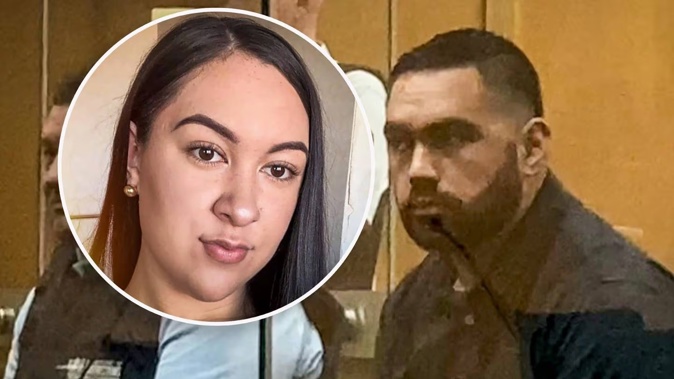

Paige Tutemahurangi was alive for “at least” 30 minutes after an alleged fatal beating by her partner, a pathologist has told a court.
The 25-year-old also had “at least” five impact zones on her face and head after the attack by Richard Mathew Coburn at their Kahikatea Dr, Hamilton, home on the evening of July 1, last year.
Coburn is on trial in the High Court at Hamilton defending a charge of murder.
Through his lawyer Roger Laybourn, he instead maintains he’s guilty of manslaughter.
The 26-year-old told police he punched Tutemahurangi “three or four times” in the head before wiping the blood off her, changing her bloodied clothes and putting her into a dressing gown.
He’s then alleged to have put her to bed before ringing 111 and carrying out CPR.
Emergency services arrived at Tutemahurangi’s Kahikatea Dr, Hamilton house soon afterwards with Sergeant Mark Schinkel flipping the bed and putting her on the floor to do CPR.
Several witnesses gave evidence yesterday, including Tutemahurangi’s mother and brother and Coburn’s brother and father.
Pathologist Dr Kilak Kesha told the jury this morning testing of neural, or brain, tissue revealed Tutemahurangi was alive for “at least” 30 minutes after the assault.
Asked by Justice Mary Peters what causes the brain to die, Dr Kesha replied, “a lack of blood supply to the brain”.
“It’s not getting the nutrients, oxygen ... and that just causes the death.”
Dr Kesha found there were “at least” five different impact sites around Tutemahurangi’s head; both eyes, forehead, and both sides of her scalp.
But he would be unable to determine if the same area was struck more than once.
“If you strike the same area more than once, there’s no way for me to tell.”
Tutemahurangi’s nose was also fractured but he was not able to conclusively say it was a separate injury or caused at the same time as a blow to her eye.
‘Hi babe just gonna finish my beer’
Text messages exchanged between the pair just prior to Coburn heading around to her house were also revealed to the jury.
“Hi babe just gonna finish my beer then I’ll come back did you want me to get anything?” Coburn asked.
“Cool as babe our dinner should be done by the time you came home and no thank you darling I thought I better not be lazy. Me and son have already been to supermarket to go get some fizzys for us xx”, Tutemahurangi replied.
Officer-in-charge Detective Ayla Pritchard detailed Coburn’s movements and phone calls that night, and confirmed he arrived at the house at 7.44pm.
There was one call - from Facebook - made from Coburn’s phone to a Tatum-Leigh Atera, at 8.32pm, that didn’t connect. That person was also unable to be identified.
The first of three calls to 111 were made at 8.37pm, the next two were both made at 8.38pm.
Detective Rowan Ware was the first to speak to Coburn at the scene, and when he asked him what happened said, “I did everything”.
Asked what that meant, Coburn said he didn’t “want to talk about it right now”.
/cloudfront-ap-southeast-2.images.arcpublishing.com/nzme/EPKDNCF2U5EQ5OVQWZT34HSDUQ.jpg)
Paige Tutemahurangi was allegedly murdered by a man in Hamilton after an incident in the city on Saturday. Photo / LinkedIn.
St John critical care paramedic Tracy Garratt arrived at the scene to find Tutemahurangi lying unconscious on the ground with “substantial bruising and swelling across the face”.
“Her heart was not beating. She was completely in a flat line.”
The flat line status meant she was “very critical and unlikely to survive was my first thought”.
Tutemahurangi’s right eye was completely swollen over, and her left eye was also bruised but “basically dilated and unreactive to light which means there’s no brain activity”.
“Basically brain dead ... and that is why her heart stopped working because of the brain injury.”
Asked by Mann how substantial her injuries were, Garratt replied, “it appeared that she had been beaten substantially to cause that kind of head injury”.
There was no fresh blood on Tutemahurangi – only dried blood.
However, she was unable to indicate a specific time frame of how long it could have taken for the blood to dry.
Senior ESR forensic scientist Fiona Matheson said three different types of blood stains were found in their scene examination; transfer, drip, and “spatter” a 1mm to 2mm stain usually caused by force or an impact.
Blood staining was found on the toilet and bedroom doors, the door frames of the toilet, and an adjacent bedroom, wall, and clothing rack in the room where Tutemahurangi was put to bed.
There was also blood on the carpet and the bottom corner of a set of drawers likely caused by it being coughed or sneezed out of the mouth, nose, or a wound at close range.
Blood was also found on clothing worn by Tutemahurangi in a laundry basket.
Coburn’s police interview will be played to the jury after lunch.
Belinda Feek is an Open Justice reporter based in Waikato. She has worked at NZME for nine years and been a journalist for 20.

Take your Radio, Podcasts and Music with you









